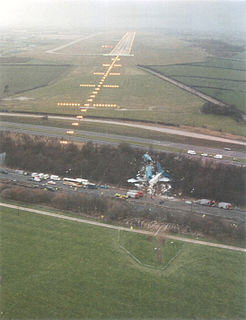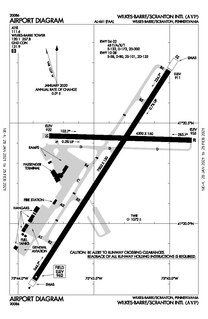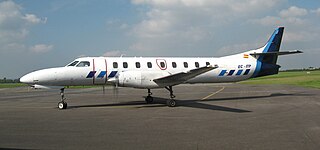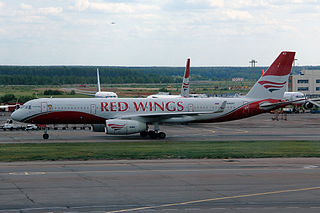Related Research Articles

General aviation (GA) is defined by the International Civil Aviation Organization (ICAO) as all civil aviation aircraft operations with the exception of commercial air transport or aerial work, which is defined as specialized aviation services for other purposes. However, for statistical purposes ICAO uses a definition of general aviation which includes aerial work.

An aviation accident is defined by the Convention on International Civil Aviation Annex 13 as an occurrence associated with the operation of an aircraft, which takes place from the time any person boards the aircraft with the intention of flight until all such persons have disembarked, and in which a) a person is fatally or seriously injured, b) the aircraft sustains significant damage or structural failure, or c) the aircraft goes missing or becomes completely inaccessible. Annex 13 defines an aviation incident as an occurrence, other than an accident, associated with the operation of an aircraft that affects or could affect the safety of operation.

The Kegworth air disaster occurred when British Midland Airways Flight 092, a Boeing 737-400, crashed onto the motorway embankment between the M1 motorway and A453 road near Kegworth, Leicestershire, England, while attempting to make an emergency landing at East Midlands Airport on 8 January 1989.

London Southend Airport is an international airport situated on the outskirts of Southend-on-Sea in Essex, England, approximately 36 miles (58 km) from the centre of London. The airport straddles the boundaries between the borough of Southend-on-Sea and the Rochford District.

China Airlines Flight 642 was a flight that crashed at Hong Kong International Airport on 22 August 1999. It was operating from Bangkok to Taipei with a stopover in Hong Kong.

Aviation safety is the study and practice of managing risks in aviation. This includes preventing aviation accidents and incidents through research, educating air travel personnel, passengers and the general public, as well as the design of aircraft and aviation infrastructure. The aviation industry is subject to significant regulation and oversight.

The Civil Aviation Authority (CAA) is the statutory corporation which oversees and regulates all aspects of civil aviation in the United Kingdom. Its areas of responsibility include:

Farnborough Airport is an operational business/executive general aviation airport in Farnborough, Rushmoor, Hampshire, England. The 310-hectare (770-acre) airport covers about 8% of Rushmoor's land area.

Plymouth City Airport is a 'mothballed' airport located within the City of Plymouth 3.5 NM north northeast of the city centre in Devon, England at Derriford. The airport opened on this site in 1925 and was officially opened by the future Edward VIII, as Prince of Wales, in 1931.

Wilkes-Barre/Scranton International Airport is mostly in Pittston Township, Pennsylvania, and spans the border between Luzerne County and Lackawanna County. It is owned and operated by the two counties; it is about 7 miles from Scranton and 8 miles from Wilkes-Barre. It is the fifth largest airport in Pennsylvania by passenger count and calls itself "your gateway to Northeastern Pennsylvania and the Pocono Mountains".

Fort Lauderdale Executive Airport is a general aviation airport located within the city limits of Fort Lauderdale, in Broward County, Florida, United States, five miles (8.0 km) north of downtown Fort Lauderdale. It is a division of the Transportation and Mobility Department of the City of Fort Lauderdale.

TACA Flight 390 was a scheduled flight on May 30, 2008, by TACA International from San Salvador, El Salvador, to Miami, Florida, United States, with intermediate stops at Tegucigalpa and San Pedro Sula in Honduras. The aircraft, an Airbus A320-233, overran the runway after landing at Tegucigalpa's Toncontín International Airport and rolled out into a street, crashing into an embankment and smashing several cars in the process.
PT ASI Pudjiastuti Aviation, operating as Susi Air, is a scheduled and charter airline based in Pangandaran, West Java, Indonesia. Sixty percent of the airline's operation serves commercial regular routes and pioneer routes while the rest is charter flights. The company currently operates from several main bases across the Indonesian archipelago. Susi Air is listed in category 2 by Indonesian Civil Aviation Authority for airline safety quality.

On 22 December 2009, an American Airlines Boeing 737-800, operating American Airlines Flight 331 and carrying 148 passengers and six crew, overran runway 12 on landing at Kingston in poor weather. The plane continued on the ground outside the airport perimeter and broke apart on the beach, causing injuries.

On 22 May 2010, a Boeing 737-800 passenger jet operating as Air India Express Flight 812 from Dubai to Mangalore, India, crashed on landing at Mangalore. The captain had continued an unstabilised approach, despite three calls from the first officer to initiate a "go-around", resulting in the aircraft overshooting the runway, falling down a hillside, and bursting into flames. Of the 160 passengers and six crew members on board, 158 were killed ; only eight survived. This was the first fatal accident involving Air India Express.

Manx2 Flight 7100 was a scheduled commercial flight from Belfast, Northern Ireland, to Cork, Republic of Ireland. On 10 February 2011, the Fairchild Metro III aircraft flying the route with ten passengers and two crew on board crashed on its third attempt to land at Cork Airport in foggy conditions. Six people, including both pilots, died. Six passengers survived but were injured, four of them seriously.

Red Wings Airlines Flight 9268 was a Tupolev Tu-204-100 passenger jet that on 29 December 2012 crashed on landing at Moscow Vnukovo Airport, Russia, following a repositioning flight from Pardubice Airport, Czech Republic. There were no passengers on board, but 5 of the 8 crew members were killed when the aircraft hit a ditch and highway structures after overrunning the runway.

Air India Express Flight 1344 was a scheduled international flight on 7 August 2020 from Dubai, United Arab Emirates, to Kozhikode, India, landing at Calicut International Airport. The flight was part of the Vande Bharat Mission to repatriate Indian nationals stranded due to the COVID-19 pandemic. The flight crew aborted two landing attempts because of heavy rain and tailwind. On the third landing attempt, the aircraft touched down on runway 10, but skidded off the end of the tabletop runway and slid down a 9–10.5 m (30–35 ft) slope, killing 19 passengers and both pilots. The four cabin crew members and 165 passengers survived, of whom 167 were injured. This was the second fatal accident involving Air India Express, after the 2010 Mangalore crash.

National Flying Services Ltd was a company aiming to create and manage a large number of airfields and flying clubs around Britain. It relied on government subsidy, and it collapsed when the subsidy was withdrawn in 1934 because the aims had not been achieved.
References
- ↑ "Strasser Scheme". Aopa.co.uk. Retrieved 20 August 2012.
- ↑ "CAP667 - Review of General Aviation Fatal Accidents 1985-1994" (PDF). Retrieved 27 November 2012.
- ↑ "£1,047 landing fee for PA-28 pilot" . Retrieved 25 March 2019.
- ↑ "Carlisle Airport joins Strasser Scheme". Ukga.com. 5 December 2011. Retrieved 20 August 2012.